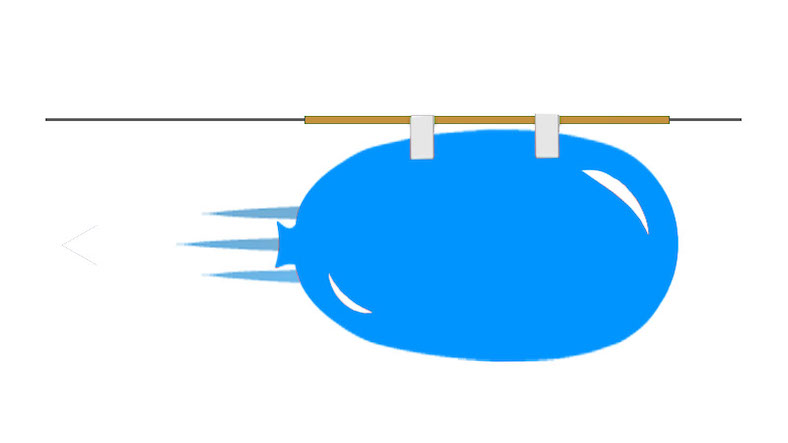Balloon Rocket Science: Exploring Newton’s Third Law of Motion
By~ Scholar Planet
Created At: 15 Apr, 2025

The world of science is full of exciting wonders, and one of the most engaging ways to explore scientific concepts is through hands-on experiments. If you're looking for a fun, interactive, and educational activity that teaches real physics principles, the Balloon Rocket Experiment is the perfect choice. Whether you're a teacher, a parent, or a curious student, this experiment brings learning to life by demonstrating Newton’s Third Law of Motion in a thrilling and memorable way.
What is the Balloon Rocket Experiment?
The Balloon Rocket Experiment is a simple yet powerful science activity that showcases the fundamental physics of action and reaction forces. It's a favorite among students and educators alike because it requires minimal materials and offers maximum impact. This DIY experiment transforms an ordinary balloon into a zooming rocket, making it the perfect way to introduce kids to Newtonian physics, forces, and motion.
🔬 Materials You’ll Need:
To conduct this experiment, you only need a few household items:
-
🎈 A balloon (any size or shape)
-
🧵 A long piece of string or fishing line
-
🥤 A plastic straw
-
📎 Tape
-
✂️ Scissors
These simple tools will help you build a mini-rocket that zips across your room, powered by nothing but air!
🚀 Step-by-Step Instructions: How to Make a Balloon Rocket
-
Prepare the Launch Line:
Tie the string between two fixed points – such as two chairs or a wall and a doorknob – so it’s tight and straight. -
Thread the Straw:
Slide the straw onto the string. This will act as the guiding tube for your rocket’s journey. -
Inflate the Balloon:
Blow up the balloon, but don’t tie the end. Hold it closed with your fingers. -
Attach the Balloon:
Tape the balloon securely to the straw, keeping the open end facing backward. -
Time for Lift-Off!
Let go of the balloon and watch it race along the string. 🎉
💡 The Science Behind the Fun: Newton’s Third Law of Motion

This experiment is a perfect demonstration of Newton’s Third Law, which states:
“For every action, there is an equal and opposite reaction.”
When you release the balloon, air rushes out in one direction (action), pushing the balloon in the opposite direction (reaction). This simple law is the same principle used by real rockets and jets for propulsion.
🧠 What Kids Learn from the Balloon Rocket Experiment
This experiment is more than just fun – it's packed with educational value. Here are the key STEM concepts students can explore:
1. Newton's Third Law in Action
Kids see firsthand how forces work in pairs. As air pushes out, the balloon moves forward – an exciting, visual way to understand action-reaction forces.
2. Introduction to Propulsion
This experiment demonstrates how thrust works, just like in real-life rockets. It's an excellent entry point to deeper topics in aerospace engineering.
3. Understanding Forces and Motion
The balloon rocket illustrates how unbalanced forces create motion – a cornerstone concept in physics and mechanics.
✅ Safety Tips
Safety first! Here are a few precautions to keep the experiment safe and fun:
-
Keep a safe distance from the rocket's path.
-
Don’t over-inflate the balloon, as it may pop.
-
Supervise younger children during the experiment.
📈 Why This Experiment is Great for STEM Learning
The balloon rocket activity is ideal for classrooms, science fairs, homeschooling, or weekend fun. It helps develop critical thinking, problem-solving skills, and a love for scientific inquiry. Plus, it encourages kids to ask questions like:
-
What happens if we change the balloon size?
-
How does the angle of the string affect motion?
-
Can we add weight to the balloon rocket?
Each variation becomes a new opportunity for discovery.
🎯 Keywords to Remember:
-
Balloon rocket experiment
-
Newton’s third law of motion for kids
-
DIY physics experiment
-
STEM activity for students
-
Forces and motion experiment
-
Hands-on science activity
🧪 Final Thoughts
Science is most powerful when it’s experienced – and the Balloon Rocket Experiment is a fantastic way to make physics fun and accessible. As the balloon zips across the string, it not only brings joy and excitement but also plants the seeds of curiosity and understanding in young minds.
So go ahead – gather your materials, set up your launchpad, and get ready to blast off into the amazing world of STEM learning!
